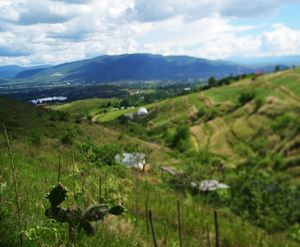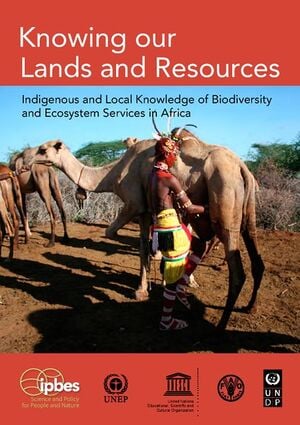
 The Reintroduction of Cheetahs in India After 70 Years, happyeconews.com (Apr 17, 2023)
The Reintroduction of Cheetahs in India After 70 Years, happyeconews.com (Apr 17, 2023)
Video gallery[edit | edit source]
Community action projects[edit | edit source]
Ecosystem restoration[edit | edit source]

 How China’s most ‘futuristic’ city restored its mangroves, dialogue.earth (Jul 11, 2024)
How China’s most ‘futuristic’ city restored its mangroves, dialogue.earth (Jul 11, 2024)  Community-led approach to mangrove restoration in southern Thailand based on beekeeping, news.mongabay.com (Jun 18, 2024)
Community-led approach to mangrove restoration in southern Thailand based on beekeeping, news.mongabay.com (Jun 18, 2024)  EU passes law to restore 20% of bloc’s land and sea by end of decade, theguardian.com (Jun 17, 2024)
EU passes law to restore 20% of bloc’s land and sea by end of decade, theguardian.com (Jun 17, 2024)
Ecosystem restoration is the process of halting and overturning degradation, resulting in cleaner air and water, extreme weather mitigation, better human health, and recovered biodiversity, including improved pollination of plants. Restoration encompasses a wide continuum of practices, from reforestation to re-wetting peatlands and coral rehabilitation.[1]
Citizen Science[edit | edit source]
Citizen Science refers to the involvement, participation and engagement of citizens in local or online (global) scientific work relevant to the citizens' interests, usually as a hobby, often as a passion.
Biodiversity[edit | edit source]
India Biodiversity Portal[edit | edit source]
The India Biodiversity Portal is a repository of information designed to harness and disseminate collective intelligence on the biodiversity of the Indian subcontinent. It is designed to seek voluntary participation of users and establish a participatory platform for content generation, verification and usage. The Portal aims to facilitate and enable widespread participation by all citizens in contributing and accessing information on Indian biodiversity, that benefits science and society, contributes to a sustainable future; and guides the development and use of the Portal.
Citizen Science: Any member of the general public can upload an observation of any species sighted. Other members help identify, annotate and curate the observations. All data on the portal is shared under Creative Commons licenses. "Open and free access to biodiversity information is essential to promote conservation, management and sustainable use of biodiversity and has immense potential to increase the current and future value of the country's biodiversity for a sustainable society."
India is one of the most biodiverse regions and is home to a large variety of wildlife. It is one of the 17 megadiverse countries and includes three of the world's 36 biodiversity hotspots – the Western Ghats, the Eastern Himalayas, and the Indo-Burma hotspot.
About 24.6% of the total land area is covered by forests. It has various ecosystems ranging from the high altitude Himalayas, tropical evergreen forests along the Western Ghats, desert in the north-west, coastal plains and mangroves along the peninsular region. India lies within the Indomalayan realm and is home to about 7.6% of mammal, 14.7% of amphibian, 6% of bird, 6.2% of reptilian, and 6.2% of flowering plant species.
Human encroachment, deforestation and poaching are significant challenges that threaten the existence of certain fauna and flora. Government of India established a system of national parks and protected areas in 1935, which have been subsequently expanded to nearly 1022 protected areas by 2023. India has enacted the Wildlife Protection Act of 1972 and special projects such as Project Tiger, Project Elephant and Project Dolphin for protection of critical species.
Conservation[edit | edit source]
India harbors 172 (2.9%) IUCN-designated threatened species. These include 39 species of mammals, 72 species of birds, 17 species of reptiles, three species of amphibians, two species of fish, and a number of insects including butterflies, moths, and beetles.
As of 2023, there are 1022 protected areas including 106 national parks, 573 wildlife sanctuaries, 220 conservation reserves and 123 community reserves. In addition, there are 55 tiger reserves, 18 biosphere reserves and 32 elephant reserves. W
Other initiatives[edit | edit source]
Defra, UK Darwin Initiative: India
Environment quality[edit | edit source]
More video: Cars choking Delhi's roads, 2007
River March, movement which seeks to "rejuvenate our rivers by striving to free them from encroachments, save remaining mangroves and contribute a non-polluted green environment." Mumbai
Air pollution in India[edit | edit source]
Air pollution in India is a serious environmental issue. Of the 30 most polluted cities in the world, 21 were in India in 2019. As per a study based on 2016 data, at least 140 million people in India breathe air that is 10 times or more over the WHO safe limit and 13 of the world's 20 cities with the highest annual levels of air pollution are in India. 51% of the pollution is caused by industrial pollution, 27% by vehicles, 17% by crop burning and 5% by other sources. Air pollution contributes to the premature deaths of 2 million Indians every year. Emissions come from vehicles and industry, whereas in rural areas, much of the pollution stems from biomass burning for cooking and keeping warm. In autumn and spring months, large scale crop residue burning in agriculture fields – a cheaper alternative to mechanical tilling – is a major source of smoke, smog and particulate pollution. India has a low per capita emissions of greenhouse gases but the country as a whole is the third largest greenhouse gas producer after China and the United States. A 2013 study on non-smokers has found that Indians have 30% weaker lung function than Europeans.
The Air (Prevention and Control of Pollution) Act was passed in 1981 to regulate air pollution but has failed to reduce pollution because of poor enforcement of the rules.
In 2015, Government of India, together with IIT Kanpur launched the National Air Quality Index. In 2019, India launched 'The National Clean Air Programme' with tentative national target of 20%-30% reduction in PM2.5 and PM10 concentrations by 2024, considering 2017 as the base year for comparison. It will be rolled out in 102 cities that are considered to have air quality worse than the National Ambient Air Quality Standards. There are other initiatives such as a 1,600-kilometre-long and 5-kilometre-wide The Great Green Wall of Aravalli green ecological corridor along Aravalli range from Gujarat to Delhi which will also connect to Shivalik hill range with planting of 1.35 billion (135 crore) new native trees over 10 years to combat the pollution. In December 2019, IIT Bombay, in partnership with the McKelvey School of Engineering of Washington University in St. Louis, launched the Aerosol and Air Quality Research Facility to study air pollution in India. According to a Lancet study, nearly 1.67 million deaths and an estimated loss of US$28.8 billion worth of output were India's prices for worsening air pollution in 2019.
Trees, woodland and forest[edit | edit source]
Peepal Baba or Swami Prem Parivartan is an environmentalist who along with his team has planted over 20 million trees in 202 districts across 18 states in India. He was born to a doctor of Indian Army on 26 January 1966 in Chandigarh, India. His English teacher inspired him at the age of 11 to plant trees in 1977. He is the founder of Give Me Trees Trust which was later registered as a non-governmental organisation in 2011. He took asceticism in 1984 from Osho Rajneesh, who gave him the name "Swami Prem Parivartan". Now he also is an inspiration for others interested in the Nature.
Jadav "Molai" Payeng (born 31 October 1959) is an environmental activist and forestry worker from Majuli, popularly known as the Forest Man of India. Over the course of several decades, he has planted and tended trees on a sandbar of the river Brahmaputra turning it into a forest reserve. The forest, called Molai forest after him, is located near Kokilamukh of Jorhat, Assam, India and encompasses an area of about 1,360 acres / 550 hectares. In 2015, he was honoured with Padma Shri, the fourth highest civilian award in India. He was born in the indigenous Mising tribe of Assam.
Wetlands[edit | edit source]
- Wikipedia: East Kolkata Wetlands
Sea level rise[edit | edit source]
Societies can adapt to sea level rise in three different ways: implement managed retreat, accommodate coastal change, or protect against sea level rise through hard-construction practices like seawalls or soft approaches such as dune rehabilitation and beach nourishment. Sometimes these adaptation strategies go hand in hand, but at other times choices have to be made among different strategies. For some human environments, such as so called sinking cities, adaptation to sea level rise may be compounded by other environmental issues such as subsidence. Natural ecosystems typically adapt to rising sea levels by moving inland; however, they might not always be able to do so, due to natural or artificial barriers. W
Maps
Land projected to be below annual flood level in 2030 and beyond, coastal.climatecentral.org
Sea Level Rise, information from climatecentral.org
Rural sustainability[edit | edit source]
Institute of Rural Management Anand, Wikipedia:Institute of Rural Management Anand - Find your feet
Urban and rural connections[edit | edit source]
section needed
Ecological emergency[edit | edit source]

There is consensus in the scientific community that the current environmental degradation and destruction of many of Earth's biota are taking place on a "catastrophically short timescale". Scientists estimate that the current species extinction rate, or the rate of the Holocene extinction, is 1,000 to 10,000 times higher than the normal, background rate. Habitat loss is the leading cause of both species extinctions and ecosystem service decline. Two methods have been identified to slow the rate of species extinction and ecosystem service decline, they are the conservation of currently viable habitat and the restoration of degraded habitat. The commercial applications of ecological restoration have increased exponentially in recent years. In 2019, the United Nations General Assembly declared 2021–2030 the UN Decade on Ecosystem Restoration. W
UN Decade on Ecosystem Restoration[edit | edit source]

 Green Deal: pioneering proposals to restore Europe's nature by 2050 and halve pesticide use by 2030, ec.europa.eu (Jun 22, 2022)
Green Deal: pioneering proposals to restore Europe's nature by 2050 and halve pesticide use by 2030, ec.europa.eu (Jun 22, 2022)  The farmers restoring Hawaii’s ancient food forests that once fed an island, theguardian.com (Jun 17, 2022)
The farmers restoring Hawaii’s ancient food forests that once fed an island, theguardian.com (Jun 17, 2022)
The UN Decade on Ecosystem Restoration 2021-2030 is a rallying call for the protection and revival of ecosystems all around the world, for the benefit of people and nature. It aims to halt the degradation of ecosystems and restore them to achieve global goals. The United Nations General Assembly has proclaimed the UN Decade and it is led by the United Nations Environment Programme and the Food and Agriculture Organization of the United Nations. The UN Decade is building a strong, broad-based global movement to ramp up restoration and put the world on track for a sustainable future. That will include building political momentum for restoration as well as thousands of initiatives on the ground.[2]
The decade was conceived as a means of highlighting the need for greatly increased global cooperation to restore degraded and destroyed ecosystems, contributing to efforts to combat climate change and safeguard biodiversity, food security, and water supply. W
See also[edit | edit source]



